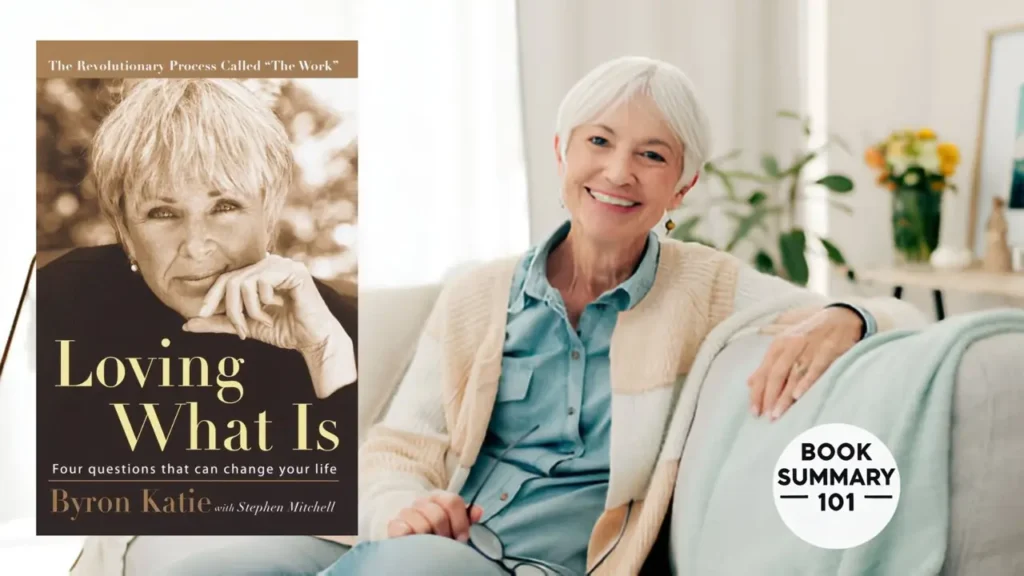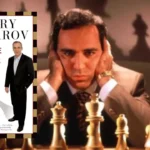Ever caught yourself spiraling in overthinking, wishing things were different, or battling life’s endless “what-ifs”? Byron Katie’s revolutionary book, Loving What Is, offers a surprising solution: stop fighting reality and start questioning your thoughts.
This book isn’t just advice—it’s a tool for transforming your inner dialogue and, ultimately, your entire life. Let’s dive in.
Why Read Loving What Is?
If you’ve ever felt stuck in negative patterns, overwhelmed by life’s challenges, or disconnected from the peace you know is possible, this book is for you. Byron Katie introduces The Work, a simple yet profound process of self-inquiry. By asking four questions, you can challenge the thoughts that hold you captive and rediscover freedom and clarity.
Katie’s approach isn’t about positive thinking or forcing gratitude—it’s about getting real with yourself in the kindest way possible.
Why This Book Resonates
Katie’s method isn’t a quick fix—it’s a practice. The beauty lies in its accessibility; anyone can do The Work, anytime, anywhere. Her stories and dialogues with clients throughout the book bring these concepts to life in relatable, often profound ways.
This isn’t about sugarcoating pain or pretending life’s challenges don’t exist. Instead, it’s about questioning the mental stories that add unnecessary suffering and discovering a way to love reality as it is.
The book on amazon 👉 Loving What is 📚
The Four Questions That Can Change Your Life
At the core of Loving What Is lies a deceptively simple yet transformative tool: The Work, a process of self-inquiry centered around four profound questions. These aren’t just questions to think about—they’re an invitation to investigate the beliefs that keep you stuck, stressed, or unhappy. Let’s explore each question in detail:
1. Is it true?
This question is where the transformation begins. It invites you to pause and take a step back from your immediate reaction.
When a thought arises—especially one that triggers frustration, sadness, or anger—ask yourself:
“Is this thought I’m believing actually true?”
At first, your answer might be an automatic yes. After all, it feels true in the moment. But don’t stop there. Slow down. Take a deep breath. Are you absolutely sure?
Example: “My friend doesn’t care about me because they haven’t called back.”
Your mind may be quick to agree: “Of course, it’s true! If they cared, they would have called!” But pause. Do you know for certain that’s the reason they haven’t called? Could they be busy, stressed, or dealing with something personal? Could they be thinking about you but just haven’t had a chance to reach out?
Byron Katie encourages us to go beyond an intellectual response and actually sit with the question. Don’t just answer—feel into it. Often, we discover that what we assumed was true is actually just a story we’ve created.
Why This Question Matters
When we take our thoughts at face value, we get caught in patterns of unnecessary suffering. But when we slow down and ask, “Is it true?” we introduce doubt into the rigid beliefs that hold us back. That tiny moment of questioning creates space for a different perspective—and that’s where real freedom begins.
2. Can you absolutely know that it’s true?
Now, let’s go deeper. Even if a thought feels true, can you absolutely know—with 100% certainty—that it is?
Often, we take our thoughts as fact without questioning them. But how often do we really know the whole story?
Example: “My boss doesn’t appreciate me.”
At first glance, this might seem true. Maybe your boss doesn’t give you much feedback, never acknowledges your hard work, or seems distant. But can you absolutely know they don’t appreciate you?
- Did they explicitly say, “I don’t appreciate you”?
- Could they be showing appreciation in ways you’re not noticing—like trusting you with responsibilities or assuming you know your value?
- Could they be stressed or distracted by their own problems, making them less expressive?
When we examine a belief like this, we often realize we’ve been filling in gaps with our own assumptions.
Why This Question Matters
This question humbles us. It makes us pause and recognize that we rarely have all the information. We see the world through our personal lens—our past experiences, insecurities, and interpretations.
By admitting, “I don’t actually know for sure,” we open ourselves up to curiosity instead of certainty, and compassion instead of judgment. This shift alone can relieve stress and open new perspectives.
Next time you find yourself believing something painful, try asking:
“Can I absolutely know this is true?”
You might be surprised by what you discover. 😊
3. How do you react—what happens—when you believe that thought?
This is where the real transformation begins. Instead of just analyzing whether a thought is true or not, this question invites you to look at its impact on your life.
When you believe a stressful thought, how does it affect you?
- Emotionally – What feelings arise? Fear, sadness, frustration?
- Physically – How does your body react? Tight chest? Tension in your shoulders? Fatigue?
- Behaviorally – How does this thought influence your actions and decisions?
Example: “I’m not good enough for this job.”
Let’s say you believe this thought completely. What happens next?
- Emotionally, you might feel anxious, insecure, or discouraged.
- Physically, your body might respond with a tight chest, heavy shoulders, or nervous energy.
- Behaviorally, you might:
- Avoid speaking up in meetings out of fear of being wrong.
- Overwork yourself to prove your worth, leading to burnout.
- Procrastinate because you don’t believe your work will be “good enough” anyway.
This question reveals the hidden cost of believing certain thoughts. It makes you see how a single belief can shape your entire experience—your mood, relationships, and even your opportunities.
Why This Question Matters
By shining a light on the effects of your thoughts, you start to see how much power they hold over you. But here’s the good news: if a thought is making you suffer, you have the ability to question it.
Once you see the damage a belief is causing, you might feel inspired to let it go. And that’s where the next question comes in: Who would you be without that thought?
4. Who would you be without that thought?
This is the game-changer. After exploring how a stressful thought affects you, this question invites you to imagine your life without it.
If you could simply drop the belief, how would you feel? How would you act? What kind of person would you be?
This isn’t about forcing positivity or pretending problems don’t exist. It’s about exploring a new reality—one where that thought no longer controls you.
Example: “My partner should always agree with me.”
When you believe this thought, you might feel frustrated, defensive, or even distant when your partner disagrees with you. Conversations may turn into arguments because you’re more focused on being right than understanding their perspective.
But what if you didn’t believe that thought?
- You might feel lighter, more open, and less reactive.
- Instead of arguing, you might listen with genuine curiosity.
- Disagreements might feel like opportunities to learn instead of threats to your relationship.
Another Example: “I’m not good enough for this job.”
With this thought, you might feel anxious, avoid challenges, or overwork yourself to exhaustion.
Without it?
- You might feel more at ease, willing to take risks, and confident in your abilities.
- You’d be present and engaged instead of stuck in self-doubt.
- Work would feel like an opportunity for growth rather than a constant test of your worth.
Why This Question Matters
This question opens the door to freedom. It allows you to step into a version of yourself that isn’t weighed down by limiting beliefs. And the best part? That version of you already exists—you just have to let go of the thoughts that keep you from seeing it.
So, ask yourself: Who would I be without this thought? You might just discover a lighter, freer version of yourself waiting on the other side.
The Turnaround: Seeing the Other Side of the Story
Once you’ve worked through the four questions, there’s one final—and often surprising—step: The Turnaround. This is where you take your original thought and flip it around to explore alternative perspectives.
The goal isn’t to force yourself to believe something new. Instead, it’s about opening your mind to possibilities you may have overlooked. When you explore different angles, you often find hidden truths that can shift your entire perspective.
How the Turnaround Works
Let’s take a few common stressful thoughts and turn them around:
Example 1: “My friend doesn’t care about me.”
Possible turnarounds:
✅ “My friend does care about me.”
- Maybe they’ve been thinking about me but haven’t reached out yet.
- Maybe they express care in ways I don’t always recognize.
✅ “I don’t care about my friend.”
- Have I reached out to them?
- Have I been expecting them to make the first move instead of checking in myself?
By considering these turnarounds, you might realize that the situation isn’t as one-sided as it seemed.
Example 2: “My boss doesn’t appreciate me.”
Possible turnarounds:
✅ “My boss does appreciate me.”
- Maybe they trust me to do my job without micromanaging.
- Maybe they show appreciation in ways I don’t notice—like giving me responsibility or not criticizing my work.
✅ “I don’t appreciate my boss.”
- Have I ever expressed appreciation for them?
- Am I only focusing on what I don’t get from them instead of what I do?
Again, the turnaround isn’t about denying your feelings—it’s about broadening your perspective.
Why the Turnaround Works
When we’re stressed, we tend to see the world through a narrow lens—one that confirms our existing beliefs. The Turnaround forces us to step outside that mindset and consider different angles.
Sometimes, a turnaround will feel just as true—or even truer—than the original belief. And that realization alone can bring a sense of peace.
Try It for Yourself
Think of a stressful thought you’ve been holding onto. Write it down. Then, experiment with a few turnarounds. Even if they don’t feel immediately true, stay open—you might be surprised at what you discover.
This final step of The Work is where the real transformation happens. Because when you see the other side of the story, you gain the power to rewrite your own.
Why These Questions Work
At first glance, Byron Katie’s four questions may seem simple. But don’t let their simplicity fool you—they’re incredibly powerful tools for breaking free from limiting beliefs and emotional suffering.
Each question peels back a layer of mental noise, self-doubt, and fear. They help you step away from automatic, knee-jerk reactions and see reality as it truly is—not as your mind has interpreted it.
Here’s why this process is so transformative:
1. They Help You See Thoughts for What They Are—Just Thoughts
Most of the time, we don’t question our thoughts. We assume they’re facts and let them shape our emotions, decisions, and relationships. But when you start asking, “Is it true?”, you create space between yourself and your thoughts. That space gives you clarity, power, and choice.
2. They Shift You from Victim to Creator
Many of us feel trapped in our circumstances, blaming people or situations for our suffering. But your thoughts—not your circumstances—create your experience of life. When you examine and shift those thoughts, you stop feeling like a victim and step into your power.
3. They Break Old Mental Patterns
We often replay the same painful stories over and over:
- “I’m not good enough.”
- “They don’t care about me.”
- “I’ll never succeed.”
These thoughts feel real because we’ve believed them for so long. But when you go through The Work, you start to see how flimsy they actually are.
4. They Bring Peace, Clarity, and Even Kindness
One of the most beautiful surprises of this practice is realizing that life is often kinder than we imagined—and so are the people in it. We just have to clear the mental fog that’s been blocking our view.
By practicing The Work, you untangle yourself from painful beliefs that have kept you stuck. And once you see through them, they lose their power over you.
So, what’s a belief that’s been holding you back? Try putting it through The Work and see what happens. You might just discover a freedom you never thought possible.
Join the Conversation!
Have you read Loving What Is or tried The Work in your own life? I’d love to hear about your experiences and insights! What’s one thought you’ve questioned—and how did it change things for you? Drop your thoughts in the comments below.
If this post resonated with you, grab a copy of the book or try applying The Work today. You might just find the peace you’ve been searching for was within you all along.
The book on amazon 👉 Loving What is 📚
five powerful quotes from Loving What Is by Byron Katie:
- “When we argue with reality, we lose—but only 100% of the time.”
- Resisting what is only leads to suffering. Peace comes from accepting things as they are.
- “The only time we suffer is when we believe a thought that argues with reality.”
- Our pain doesn’t come from events themselves but from the stories we attach to them.
- “You move totally away from reality when you believe that there is a legitimate reason to suffer.”
- Often, we justify our pain instead of questioning the thoughts causing it.
- “Placing the blame or judgment on someone else leaves you powerless to change your experience; taking responsibility for your beliefs and judgments gives you the power to change them.”
- Freedom comes when we take ownership of our thoughts rather than blaming others.
- “As long as you think that the cause of your problem is ‘out there’—as long as you think that anyone or anything else is responsible for your suffering—the situation is hopeless.”
- Real change happens when we look inward instead of waiting for external circumstances to shift.
Each of these quotes holds a deep truth that can transform the way we see life. Which one resonates with you the most?



Reading this evokes a sense of presence, of inhabiting a space where observation and thought meet quietly, without distraction or urgency.